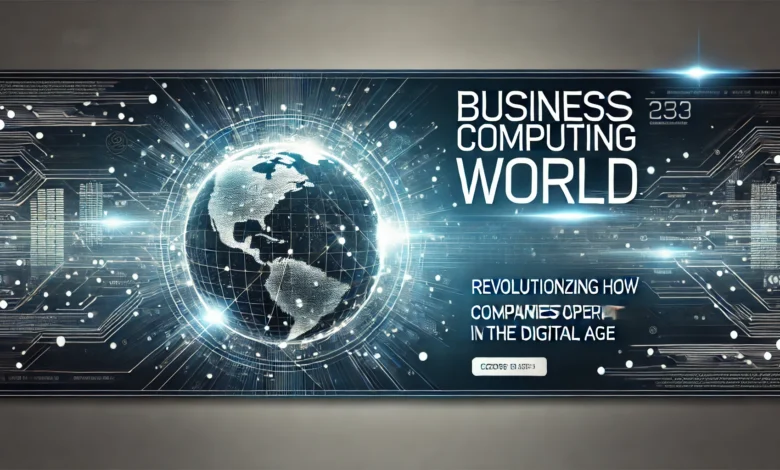Business Computing World: Navigating Technology in the Modern Era

Introduction to Business Computing World
In today’s fast-paced digital age,Business Computing World technology is no longer just a support system for businesses—it’s the very foundation upon which they thrive. The term Business Computing World encompasses the integration of computing technologies, systems, and practices that enable organizations to operate efficiently, securely, and competitively. From cloud platforms to artificial intelligence, the world of business computing has grown into a massive ecosystem that touches nearly every industry.
Over the past few decades, computing in business has evolved from simple word processors and spreadsheets to complex, data-driven infrastructures. What used to be limited to desktop applications has now expanded into global networks, enabling businesses to reach audiences across continents in real-time. This shift has not only redefined how companies work but has also changed customer expectations.
When we talk about the Business Computing World, we’re not just speaking about hardware and software—we’re also diving into strategy, innovation, and culture. Companies that fail to embrace modern computing often find themselves falling behind. On the other hand, those who adapt quickly are rewarded with efficiency, scalability, and a competitive edge.
The Evolution of Business Computing
The story of Business Computing World starts with the advent of mainframe computers in the mid-20th century. Back then, only large corporations and government organizations could afford to maintain these giant machines, and their main role was processing transactions or storing large volumes of data. Fast-forward to the 1980s and 1990s, and the introduction of personal computers brought technology into smaller offices and homes, changing the landscape forever.
With the rise of the internet in the late 1990s, businesses entered a new era. Suddenly, email, websites, and online databases became the standard. This period marked the beginning of globalization through technology, allowing even small businesses to compete internationally. The dot-com boom, though chaotic, laid the groundwork for e-commerce and digital marketing—both of which remain pillars of business computing today.
Today, the evolution continues with artificial intelligence, blockchain, Internet of Things (IoT), and machine learning reshaping industries. Businesses now rely heavily on predictive analytics, automation, and cloud services to stay competitive. The transformation has been rapid, but the principle remains the same: businesses that use computing effectively have an undeniable advantage over those that don’t.
Key Components of the Business Computing World

To understand the scope of the Business Computing World, it’s essential to break it down into its core components. At the heart of it all are hardware, software, networks, and data. These four elements work together to drive productivity, efficiency, and innovation.
Hardware includes everything from servers and computers to mobile devices and IoT gadgets. Without physical infrastructure, software has no platform to run. On the other hand, software empowers businesses with tools ranging from simple accounting programs to enterprise-level resource planning systems.
Networking is another crucial aspect. The ability to connect globally in seconds is what allows businesses to collaborate across continents, reach customers instantly, and scale operations efficiently. And finally, data has become the new currency. The way businesses collect, analyze, and leverage data determines their ability to predict trends, understand customers, and make better decisions.
These components are not static—they are constantly evolving. Cloud computing, for instance, has revolutionized how businesses handle infrastructure, offering flexibility and scalability at a fraction of traditional costs. Similarly, cybersecurity tools are advancing to protect sensitive information in an increasingly hostile digital environment.
The Role of Cloud Computing in Business
Among the most transformative forces in the Business Computing World is cloud computing. In the past, businesses had to maintain expensive servers, deal with storage limitations, and manage complex IT teams. With cloud solutions, all of that has shifted. Organizations now rent computing power and storage on demand, allowing them to scale up or down effortlessly.
Cloud computing also democratized technology for small and medium businesses. Startups that couldn’t previously afford advanced IT infrastructure can now access powerful tools at a low cost. This has leveled the playing field, encouraging innovation and competition. Collaboration tools like Google Workspace and Microsoft 365 are prime examples of how the cloud makes real-time teamwork possible, regardless of geographic location.
Moreover, the cloud has paved the way for remote work and digital-first business models. Without cloud platforms, the massive global shift to remote operations during the COVID-19 pandemic would have been nearly impossible. Businesses that had already embraced the cloud found themselves ahead of the curve, while others scrambled to catch up.
Data: The Lifeblood of Business Computing
If cloud computing is the backbone, then data is the lifeblood of the Business Computing World. Every click, purchase, or interaction generates data, and companies that can harness this information hold a significant advantage. Data-driven decision-making has become a non-negotiable practice for businesses that want to stay relevant.
For example, companies like Amazon and Netflix thrive because they use data to personalize user experiences. They analyze browsing history, buying patterns, and preferences to offer recommendations that feel almost uncanny. This level of personalization not only improves customer satisfaction but also increases profitability.
But with great power comes great responsibility. The misuse or mishandling of data can lead to trust issues, regulatory penalties, and even business collapse. That’s why data governance and compliance with laws like GDPR and CCPA are now central to business computing strategies. Managing data responsibly while extracting insights is a delicate balance that companies must master.
Cybersecurity Challenges in Business Computing
As businesses become more dependent on technology, the risks grow as well. Cybersecurity is one of the most pressing concerns in the Business Computing World. Every year, cyberattacks cost organizations billions of dollars globally. Threats range from phishing emails and ransomware attacks to sophisticated breaches targeting critical infrastructure.
Small businesses are especially vulnerable because they often lack robust security measures. Hackers frequently target them as entry points into larger supply chains. A single breach can lead to financial losses, reputational damage, and even the collapse of a business.
To mitigate risks, organizations must adopt layered security approaches. This includes firewalls, intrusion detection systems, employee training, and regular audits. Cybersecurity is no longer just an IT department concern—it has become a boardroom-level issue. Companies that treat security as an afterthought risk not only their data but also their customers’ trust.
The Future of the Business Computing World
Looking ahead, the Business Computing World will continue to evolve in ways we can only partially predict. Artificial intelligence and machine learning are set to automate more processes, from customer service chatbots to advanced financial forecasting. Blockchain may redefine supply chains, contracts, and data security. The rise of 5G will enable faster, more reliable communication, supporting innovations like augmented reality (AR) and virtual reality (VR).
One trend that stands out is the fusion of human creativity with machine efficiency. While machines handle repetitive tasks and large-scale data analysis, humans will focus more on strategy, innovation, and building relationships. Businesses that successfully combine the two will stay ahead in this increasingly digital-first world.
Sustainability is also emerging as a major focus. Energy-efficient computing, green data centers, and eco-friendly practices will shape the next chapter of business computing. Organizations that prioritize sustainability in their computing strategies will not only reduce costs but also build stronger reputations with eco-conscious customers.
Conclusion
The Business Computing World is vast, dynamic, and ever-changing. From its early days of mainframes to today’s cloud-based infrastructures and AI-driven systems, the journey has been nothing short of revolutionary. For businesses, computing is no longer optional—it’s the cornerstone of survival and growth.
Organizations that adapt quickly to new technologies while keeping an eye on security, data governance, and sustainability will thrive in the years ahead. On the other hand, those resistant to change risk being left behind in a rapidly evolving landscape.
Ultimately, the Business Computing World is about more than technology—it’s about the people, processes, and ideas that drive progress. As businesses continue to explore new frontiers, one thing is certain: computing will remain at the heart of innovation and success.



